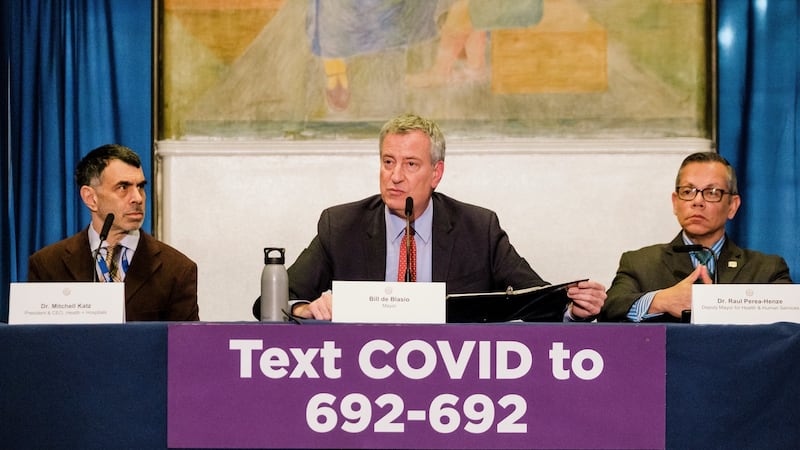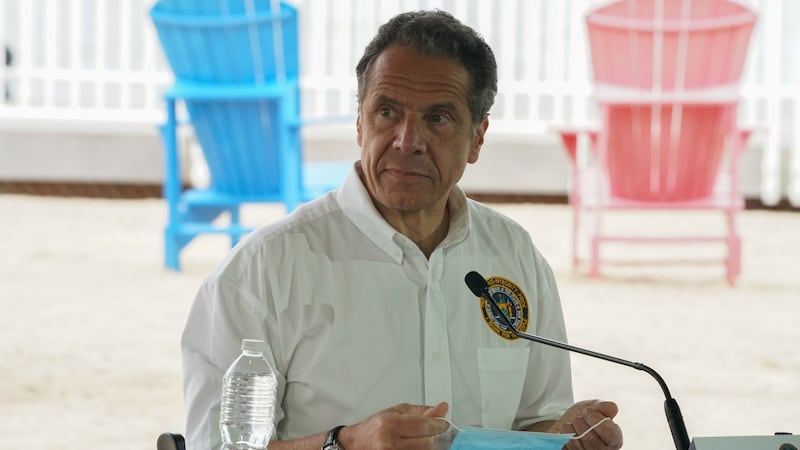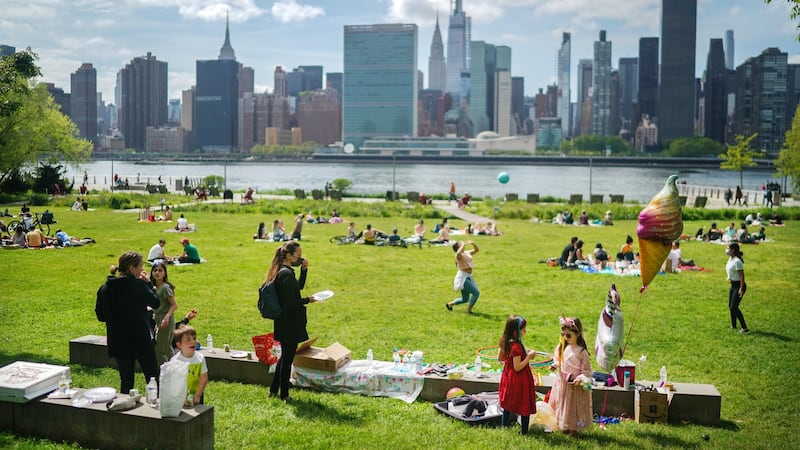Just over a year ago, before the modern plague descended, Manhattan’s Hudson Yards threw a launch party that was Versailles-like in its overabundance of champagne, oysters, top chefs, beautiful people and other trappings of a great city.
But on a recent afternoon, Hudson Yards was a ghost town. Its 93,000sq m shopping mall was shuttered and its anchor tenant, Neiman Marcus, would soon declare bankruptcy. The Vessel public art sculpture – likened by one reviewer to a giant doner kebab, and usually teeming with tourists – was empty but for a security guard patrolling its base.
The only foot traffic was a steady stream of soldiers, who had been treating Covid-19 patients at the hastily-erected field hospital at the nearby Javits convention centre. They were lined up, at six-foot intervals, to collect free meals at a Hudson Yards storefront that had been converted into a soup kitchen.
Alongside them were delivery drivers, postal workers, office cleaners and others manning the frontlines in New York City’s struggle against coronavirus.
The tableau is a reminder of how drastically the virus has transformed New York, which has potentially suffered more deaths than any other city in the world, in just a matter of weeks. As New Yorkers inch towards a reopening, probably next month, according to mayor Bill de Blasio, they are contemplating with trepidation how their city will emerge from the pandemic – and what sort of future it will find on the other side.

More than other large cities, New York exemplifies the urban characteristics that the virus has turned into vulnerabilities – population density, sky-high cost of living, a reliance on retail, culture and tourism and a dependence on crowded public transport.
The modern history of New York City is one of periodic disasters shadowed by the fear of exodus – to other cities that are cheaper, safer, more convenient. There was the 1970s fiscal crisis and the decay that followed; the 1987 stock market crash; the September 11th, 2001 terrorist attacks; and the 2008 financial crisis – not to mention various hurricanes, floods and power outages.
Yet in each case the doomsayers were proved wrong. The city bounced back stronger than before, and in some ways, reinvented itself. September 11th, for example, gave rise to a more vibrant downtown and set in motion Hudson Yards, a $25 billion development on Manhattan’s west side that is North America’s largest.
After 2008, the world’s financial capital morphed into a technology hub to rival Silicon Valley and strengthened its magnetic pull on a new generation of talent.
"No one is working in New York because it's cheaper or easier. Nobody. It's because the talent is here," says Mary Ann Tighe, chair for the tri-state area at CBRE, the real estate services group.
Reflexive faith
Carl Weisbrod, a veteran of city government who led the revival of Times Square in the late 1980s under Ed Koch and was recently appointed by de Blasio to a new task force to guide the city's recovery, acknowledges that the next 18 months will be difficult. But he also concludes that "as long as New York holds on to its talent, I have no doubt whatsoever that, as an economic matter, it will recover".
Other civic leaders tend to echo that reflexive faith in New York’s future. Some even talk about a unique opportunity to reimagine the city – to clear away nettlesome business regulation built up over generations, attract new industries, or correct the social inequities exposed by the crisis.
As de Blasio said recently: “If ever there was a moment, a breakpoint moment, in the city’s history, this is it. It’s time to look anew at everything we do and see what works, what doesn’t work.”
Before New York can set about reinventing itself there is uncertainty, even among its most ardent supporters, as to how the city will bridge the immediate catastrophe. Many are plagued by a troubling sense that this time is different.
"This is much more complicated," says Carol Kellermann, who ran the charitable fund created after the September 11th terror attack and also led the Citizens Budget Commission advisory group. "I think it's going to have much deeper, longer-lasting impacts."
September 11th was brutal and devastating but the world rallied around the city and its economy resumed within days. After 2008, New York City ended up benefiting from policies that pumped vast sums of liquidity into the financial system.
With coronavirus, there is no quick fix in sight. The city’s morgues are overflowing after more than 21,000 fatalities – roughly eight times the city’s toll from the 9/11 attacks – and some are forecasting unemployment will rise to 20 per cent in June. Yet the city is arousing less sympathy from the nation than partisan resentment. New York feels alone.
Worst of all, the very thing that distinguishes New York City and accounts for its unique alchemy – its density –is what makes it so vulnerable to the pandemic. “Other than better treatments and a vaccine, I don’t know that there’s any government policy that can make people feel safer,” Kellermann says.
Those with the means have left, quarantining in places such as the Hamptons, Palm Beach and Aspen. How many will have gone for good, she wonders, if the city’s cultural life is effectively closed and therefore unable to offset its high taxes and other indignities.
"There's definitely going to be urban flight," says Winston Fisher, a third-generation developer, who voiced an ever-present fear among New Yorkers of a certain vintage about a reversion to the bad old days. "I grew up in the city. I've been robbed at gunpoint. I remember what 59th and 6th used to look like, Times Square," he recalls. "New York City can be bad. Don't forget that."
Decontamination
To prevent that, there is an emerging consensus that authorities must create a sense of safety, just as they managed to do after September 11th. Otherwise, it will be impossible to restore business – let alone bring back tourists. It is a public health challenge but also a psychological one.
In the absence of a vaccine, the governor of New York state, Andrew Cuomo, has turned to former mayor Michael Bloomberg to spearhead a testing and tracing system. The hope is that as the city begins to reopen, the testers will be able to quickly find new infections and seal them off before they become outbreaks. As Cuomo readily acknowledges, it is a huge undertaking.

Meanwhile, developers are rushing to refit office buildings that had been designed to accommodate a taste for ever-increasing density. Lifts are being reprogrammed to respond to smartphone apps so there is no need for users to touch a button. Internal doors are being removed for the same purpose.
A critical focus in this decontamination is the world's biggest – and possibly most blighted – underground system. The Metropolitan Transportation Authority has begun a regime that would have been unimaginable just a few months ago: to scrub and disinfect each subway car and station every single day.
"New York City and the MTA are fundamentally built on density. That density creates intellectual collaboration and culture and business and Wall Street and finance and design," says Pat Foye, the MTA chairman, explaining the subway's essential role as the circulatory system for a global metropolis.
Foye predicts that new cleaning technologies “could be real game-changers in terms of public confidence in the system”. But cleanliness will come at a cost: he estimates “hundreds of millions of dollars” in additional expense at a time when passenger traffic and fare revenue are down by more than 90 per cent.
The MTA has received $3.9 billion (€3.6 bilion) in emergency funding from the federal government and is already pleading for another $3.9 billion infusion just to make it through this year.
That is but one example of the fiscal challenges now lurking at every turn. De Blasio, whose administration has added 30,000 workers to the city’s payroll since he took office in 2014, has estimated the budget shortfall caused by the virus shutdown at $7.4 billion. Others have put it closer to $10 billion.
Whatever the figure, Seth Pinksy, who led economic development during the Bloomberg administration, worries that it may pose the most direct threat to a virtuous circle in which talent and companies have chased each other to the city.
“The key to New York’s success over the last 20-plus years has been the first-class workforce it has been able to attract,” says Pinsky, who recently took over as the head of the 92nd Street Y, one of the city’s leading cultural institutions. “What I worry about is that as government starts to react to the fiscal situation we are going to be forced to make cuts to basic services that are going to be so devastating that they will undermine the quality of life in the city.”
Punishing tax cut
Finding ways to preserve restaurants, museums, galleries and the like was not just “having a soft spot for arts and culture”, Pinsky says. Rather, it was essential to maintain the appeal – and viability – of an otherwise expensive and challenging place to live.

When Donald Trump was elected president, some New Yorkers consoled themselves that he was, at least, one of them, and could therefore be counted on to look out for the city's interests. But his sustained hostility to the city that voted overwhelmingly against him in 2016 is dimming hopes for federal support.
Trump's 2017 tax cut was largely paid for by punishing New York and a group of other, Democratic-leaning high-tax states. Even if Trump were inclined to help, Mitch McConnell, the Senate majority leader, has dismissed pleas for coronavirus aid as "blue-state bailouts".
After September 11th, Bloomberg responded to the downturn by raising property taxes, a stream of revenue that accounts for nearly a third of New York City’s $89 billion budget. But that trick will not be easily repeated.
Developers may be in no position to shoulder a heavier financial burden at a time when many of their own tenants have stopped paying rent. They are also confronting a larger fear: after a crash course in remote working, some of the city's biggest employers – including BlackRock and Morgan Stanley – have announced they will require less office space in the future. If that conclusion is widespread, then Manhattan property values may be headed for a reckoning.
Even before coronavirus, the wealthy were beginning to flee the city's rising taxes for places such as Florida and Texas. "People are leaving New York and they're leaving New York in droves," says Norman Radow, a one-time New York developer who is now based in Atlanta. The coronavirus, he adds, "is just the icing on the cake".
Still, Radow’s own experience made him wonder if there might be investment opportunities ahead. He first moved to Manhattan in 1978, the depths of the fiscal crisis, and bought a two-bedroom apartment for $63,000. “Everyone thought it was the end of New York,” he recalls. “And look what happened.”
Next phase
Amid the wreckage there are shards of hope. Some are warming to the possibility that a city that became so overheated in this cheap-money era – a bastion of billionaires, ensconced in Hudson Yards – might now undergo a pandemic-induced reset. Cheaper rents may eventually make the city more accessible for a new generation, who will put spaces to use in ways their elders can scarcely imagine.
"It always happens after every crisis. It seeds the next phase," says Daniel Kaplan, senior partner at architecture firm FXCollaborative. The shared workspaces provider WeWork, Kaplan notes, was born from the unused office space left in the wake of the 2008 crisis.
Kellermann agrees: “My daughter, who’s 35, says it’s going to go back to what it was in the ’70s and ’80s – grittier, but more risk-takers.” (She acknowledges that her daughter had not actually experienced New York in the 1970s – a time when the annual murder rate breached 2,000 and the subway was off-limits after nightfall.)
Fisher now sees a rare chance to streamline an antiquated city government and improve the flow of credit to small businesses. Like other members of the business community, he would also like the city to prioritise the life sciences industry as a next source of high-paying jobs – just as the Bloomberg administration cultivated the tech sector.
Even with Amazon's decision last year to cancel plans for a second headquarters in Queens, New York City has still managed to attract billions of dollars in investment from the online retailer, and Facebook and Google, that have shined and reshaped the city's west side, including Hudson Yards.
Weisbrod wants to build more affordable housing. “I think the pendulum has swung way too far against development,” he says. “Everybody says they want more affordable housing but nobody wants it in their neighbourhood.”
With coronavirus prying open the public’s eyes to the disparities between rich and poor, there may be the chance. At the same time, Weisbrod and other civic leaders worry how the crisis will eventually shape the city’s politics. Will it be a constructive force that brings reform – or a divisive one that ultimately pits communities against one another?
The race next year to succeed de Blasio as mayor may be one of the most consequential campaigns in the city’s modern history. Will his successor be another self-described “progressive” or a member of the executive class, in the mold of Bloomberg – or something else entirely? Whoever prevails should have faith in New York’s resilience but also, as Pinsky warns, not forget its darker days.
“Those were ugly times,” he says of the 1970s, when New York City’s economic base was wrecked and its population shrank by 800,000 residents. “It took us decades to crawl out of that hole. We should be very careful about not falling back in.” – Copyright The Financial Times Limited 2020

















